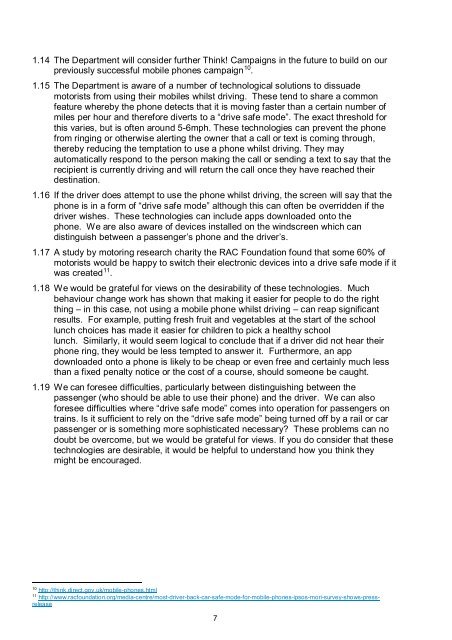whilst driving
23vrJcJ
23vrJcJ
You also want an ePaper? Increase the reach of your titles
YUMPU automatically turns print PDFs into web optimized ePapers that Google loves.
1.14 The Department will consider further Think! Campaigns in the future to build on our<br />
previously successful mobile phones campaign 10 .<br />
1.15 The Department is aware of a number of technological solutions to dissuade<br />
motorists from using their mobiles <strong>whilst</strong> <strong>driving</strong>. These tend to share a common<br />
feature whereby the phone detects that it is moving faster than a certain number of<br />
miles per hour and therefore diverts to a “drive safe mode”. The exact threshold for<br />
this varies, but is often around 5-6mph. These technologies can prevent the phone<br />
from ringing or otherwise alerting the owner that a call or text is coming through,<br />
thereby reducing the temptation to use a phone <strong>whilst</strong> <strong>driving</strong>. They may<br />
automatically respond to the person making the call or sending a text to say that the<br />
recipient is currently <strong>driving</strong> and will return the call once they have reached their<br />
destination.<br />
1.16 If the driver does attempt to use the phone <strong>whilst</strong> <strong>driving</strong>, the screen will say that the<br />
phone is in a form of “drive safe mode” although this can often be overridden if the<br />
driver wishes. These technologies can include apps downloaded onto the<br />
phone. We are also aware of devices installed on the windscreen which can<br />
distinguish between a passenger’s phone and the driver’s.<br />
1.17 A study by motoring research charity the RAC Foundation found that some 60% of<br />
motorists would be happy to switch their electronic devices into a drive safe mode if it<br />
was created 11 .<br />
1.18 We would be grateful for views on the desirability of these technologies. Much<br />
behaviour change work has shown that making it easier for people to do the right<br />
thing – in this case, not using a mobile phone <strong>whilst</strong> <strong>driving</strong> – can reap significant<br />
results. For example, putting fresh fruit and vegetables at the start of the school<br />
lunch choices has made it easier for children to pick a healthy school<br />
lunch. Similarly, it would seem logical to conclude that if a driver did not hear their<br />
phone ring, they would be less tempted to answer it. Furthermore, an app<br />
downloaded onto a phone is likely to be cheap or even free and certainly much less<br />
than a fixed penalty notice or the cost of a course, should someone be caught.<br />
1.19 We can foresee difficulties, particularly between distinguishing between the<br />
passenger (who should be able to use their phone) and the driver. We can also<br />
foresee difficulties where “drive safe mode” comes into operation for passengers on<br />
trains. Is it sufficient to rely on the “drive safe mode” being turned off by a rail or car<br />
passenger or is something more sophisticated necessary? These problems can no<br />
doubt be overcome, but we would be grateful for views. If you do consider that these<br />
technologies are desirable, it would be helpful to understand how you think they<br />
might be encouraged.<br />
10<br />
http://think.direct.gov.uk/mobile-phones.html<br />
11<br />
http://www.racfoundation.org/media-centre/most-driver-back-car-safe-mode-for-mobile-phones-ipsos-mori-survey-shows-pressrelease<br />
7


